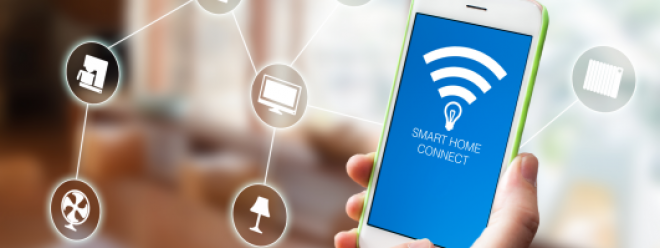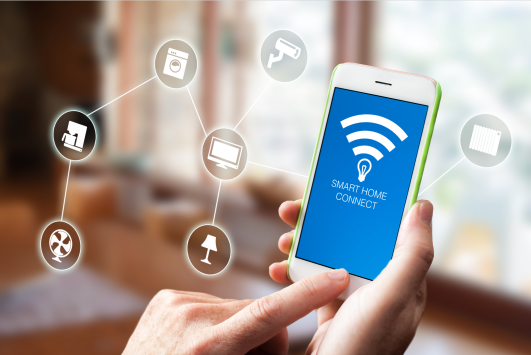Wi-Fi HaLow: A Solution for the Smart Home

Wi-Fi HaLow: A Solution for the Smart Home

Is your "smart" home behaving like a dumbass? There is still hope. Wi-Fi Halow provides a secure and reliable connection to all your connected devices. Consumers have embraced the concept of relying on convenient, connected devices to automate functions in their home. Gone are the days of manually setting the thermostat or setting the lights on a mechanical timer. These functions can now be controlled from anywhere via a smartphone app, or even via artificial intelligence in the cloud. Broadband service connections provide homes with ample bandwidth and low latency, but good wireless connections between modems and devices have proven elusive.
Is Wi-Fi the answer?
Wi-Fi is the final link that ties everything together. Manufacturers are scrambling to meet demand for connected appliances, security systems, door locks, switches, lights, garage door openers and virtual assistant speakers. By providing homeowners with new conveniences and capabilities while gathering analytics and expanding diagnostic capabilities, manufacturers have found ways to offset the additional manufacturing and maintenance costs of connected devices. Consumers believe that device manufacturers use a secure and reliable architecture to deploy and maintain their services.
However, some common issues plague the various usage scenarios of these connected products. High power consumption, dead spots, and poor coverage due to different home building techniques and construction materials of traditional Wi-Fi connections. Additionally, the 2.4GHz and 5GHz radio frequency spectrum is crowded, deployment/setup procedures are complicated, and hackers exploit security holes. Consumer expectations for simple, reliable and secure connectivity have driven manufacturers to cobble together a suite of proprietary wireless technologies that are costly to install.
Consumers are forced to use proprietary wireless hub devices that run on Zigbee, Z-wave, Bluetooth and other non-standard RF technologies and connect them to Wi-Fi routers. They come to believe that the battery or AC power needs to be replaced frequently. They are forced to use network extenders for devices that are far from the router. In the absence of a better long-range solution, manufacturers have relied on battery-hungry cellphone technology, charging constant subscription fees and unpredictable data usage charges. Hackers exploited security holes in weakly protected authentication protocols on devices that do not have OTA update capabilities to address new threats.
Advantages of Wi-Fi HaLow
IEEE 802.11ah Wi-Fi HaLow? is a technology that can solve the problems faced by existing wireless solutions, using scalable industry standards. It is built for the specific needs of IoT devices. Wi-Fi halo features longer range, lower power consumption, better penetration of building materials, ample bandwidth, improved network capacity, ease of deployment and installation, lifecycle security, over-the-air (OTA) updates, and low Material costs. Let's examine each of these requirements individually:
1. Distance
Sub-1GHz Wi-Fi HaLow frequencies using 1MHz narrow channels can transmit up to ten times farther than traditional Wi-Fi without the need for a network extender. Battery-powered cameras can be placed where they are more convenient, where they are needed outside the walls of the home or garage. The lighting system can be controlled by one AP, regardless of whether the lighting equipment is indoors or outdoors. Providing customers with a solution that can reach distances of 100 million meters without additional extenders or cellular data plans is a huge competitive advantage.
2. Power
Wi-Fi HaLow requires less power than traditional Wi-Fi to reach greater distances while providing adequate two-way data transmission. IEEE 802.11ah specifies various new sleep modes that allow devices to remain in a very low power state for extended periods of time, saving battery energy.
3. Battery consumption
Wi-Fi HaLow can be powered by a simple coin cell battery with an average power consumption of less than 10uW. With such low power consumption, HaLow can be used in devices that historically had to rely on Zigbee, Bluetooth or proprietary technologies.
4. Penetration rate
The through-building advantage of Wi-Fi HaLow will reduce the customer service calls and product returns that plague common Wi-Fi-based products. The lower frequencies used by Wi-Fi HaLow penetrate a variety of building materials better than 2.4GHz and 5GHz, while consuming less power. Wi-Fi HaLow uses OFDM modulation to correct for reflections and multipath environments. Regardless of whether the device manufacturer's product is placed indoors or outdoors, or placed in the basement or attic, it can ensure a reliable connection with the AP's HaLow. This eliminates the added complexity and cost of providing a dedicated hub or bridge device to compensate for the various home architectures of consumers worldwide.
5. Bandwidth
Similar to traditional Wi-Fi, Wi-Fi HaLow can automatically scale bandwidth based on signal integrity and distance from the AP. These predefined modulation and coding scheme (MCS) levels support bandwidths from 150Kbps to 40Mbps for single-stream, single-antenna (1×1) products, using channel widths between 1, 2, 4, and 8MHz, using optional 16MHz Wide channel with up to 80Mbps capability. Automatic selection of the most suitable MCS rate ensures fast data transfer.
This is important because faster data transfers use less battery power and the less time devices need to be on the airwaves, leaving them free for other devices to use.
6. Security
IEEE 802.11ah includes the latest Wi-Fi certification requirements (WPA2/WPA3) and AES encryption for over-the-air traffic.
7. Capacity
A single Wi-Fi HaLow AP can address up to 8191 devices. That capacity should be enough to cover all the light bulbs, door locks, shades, thermostats, and every imaginable future smart home device.
The reliable and connected choice
A typical home Wi-Fi router only supports a few dozen devices. If deployed into homes by broadband service providers, Wi-Fi HaLow APs can be a platform for generating additional revenue by subscribing to security and utility management equipment and services for one or more homes in the neighborhood. HaLow is a star network topology that does not suffer from the capacity issues of mesh networks. In a mesh network, the radio spectrum becomes crowded and the same messages are sent repeatedly.